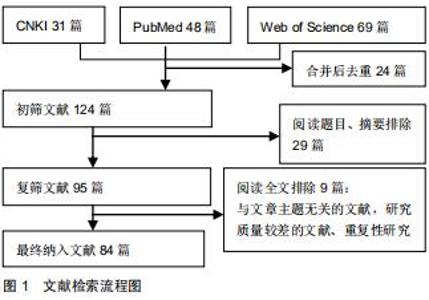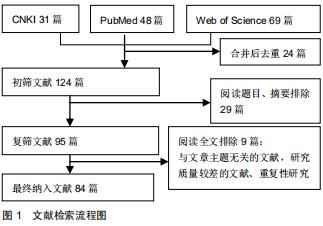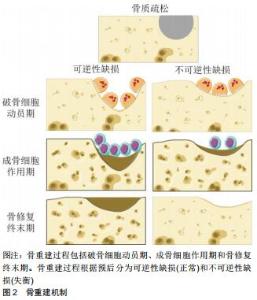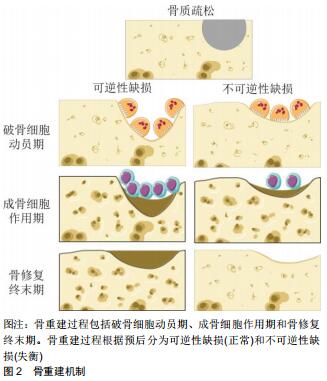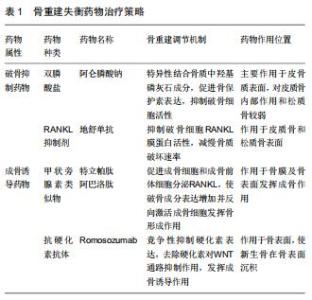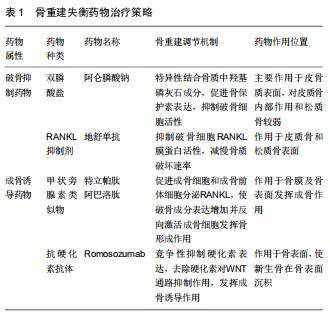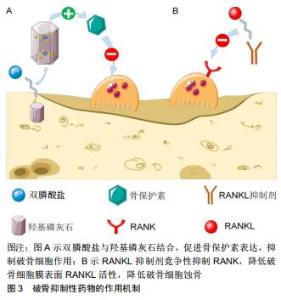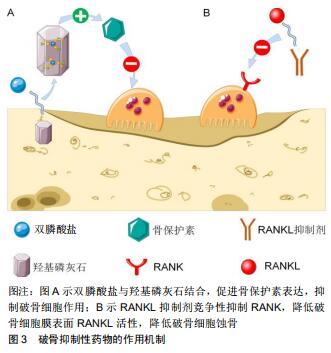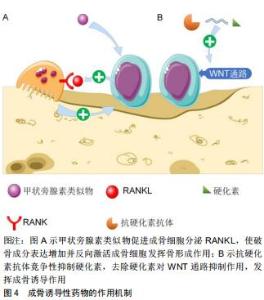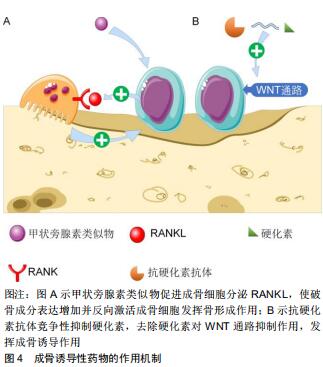Chinese Journal of Tissue Engineering Research ›› 2020, Vol. 24 ›› Issue (30): 4866-4874.doi: 10.3969/j.issn.2095-4344.2843
Previous Articles Next Articles
Action mechanism of bone remodeling imbalance in osteoporosis and relevant medical treatment strategy
Yan Wei1, Wang Zhonghan2, Liu He2
- 1Department of Emergency Trauma Surgery, Xinyang Central Hospital, Xinyang 464000, Henan Province, China; 2Department of Orthopedics, Second Hospital, Jilin University, Changchun 130041, Jilin Province, China
-
Received:2020-02-10Revised:2020-02-17Accepted:2020-03-20Online:2020-10-28Published:2020-09-22 -
Contact:Liu He, MD, Attending physician, Department of Orthopedics, Second Hospital, Jilin University, Changchun 130041, Jilin Province, China -
About author:Yan Wei, Associate chief physician, Department of Emergency Trauma Surgery, Xinyang Central Hospital, Xinyang 464000, Henan Province, China -
Supported by:the Youth Talent Promotion Project of Jilin Province from 2019 to 2020, No. 192004
CLC Number:
Cite this article
Yan Wei, Wang Zhonghan, Liu He. Action mechanism of bone remodeling imbalance in osteoporosis and relevant medical treatment strategy[J]. Chinese Journal of Tissue Engineering Research, 2020, 24(30): 4866-4874.
share this article
|
[1] CHRISTENSEN K, DOBLHAMMER G, RAU R, et al. Ageing populations: the challenges ahead. Lancet. 2009;374(9696): 1196-1208.
[2] PARFITT AM. Age-related structural changes in trabecular and cortical bone: cellular mechanisms and biomechanical consequences. Calcif Tissue Int. 1984;36 Suppl 1:S123-128.
[3] 周丕琪,沈霖,杜靖远,等.绝经后骨质疏松症与血清IL-6,TNF-α浓度关系的临床研究[J].中国骨质疏松杂志,2001,7(1):5-7+12.
[4] ANARGYROU K, FOTIOU D, VASSILAKOPOULOS TP, et al. Low bone mineral density and high bone turnover in patients with Non- Hodgkin's Lymphoma (NHL) who receive frontline therapy: results of a multicenter prospective study. Hemasphere. 2019;3(6):e303.
[5] 林雅静,卢玉燕,王燕.骨吸收抑制剂在骨质疏松治疗中的合理用药分析[J].中国医药科学,2019,9(21):74-77.
[6] RAGHUVANSHI A, KUMAR A, TYAGI AM, et al. 3-Piperidylethoxypterocarpan: A potential bone anabolic agent that improves bone quality and restores trabecular micro-architecture in ovariectomized osteopenic rats. Mol Cell Endocrinol. 2017;448:41-54.
[7] SEEMAN E, DELMAS PD. Bone quality--the material and structural basis of bone strength and fragility. N Engl J Med. 2006;354(21):2250-2261.
[8] MAERZ T, KURDZIEL M, NEWTON MD, et al. Subchondral and epiphyseal bone remodeling following surgical transection and noninvasive rupture of the anterior cruciate ligament as models of post-traumatic osteoarthritis. Osteoarthr Cartilage.2016;24(4): 698-708.
[9] BUENZLI PR, PIVONKA P, SMITH DW. Bone refilling in cortical basic multicellular units: insights into tetracycline double labelling from a computational model. Biomech Model Mechanobiol. 2014; 13(1):185-203.
[10] HATTNER R, EPKER BN, FROST HM. Suggested sequential mode of control of changes in cell behaviour in adult bone remodelling. Nature.1965;206(983):489-490.
[11] BUENZLI PR, PIVONKA P, SMITH DW. Spatio-temporal structure of cell distribution in cortical bone multicellular units: a mathematical model. Bone. 2011;48(4):918-926.
[12] SRINIVASAN K, MIJARES DQ, JANAL MN, et al. In vivo efficacy of calcium phosphate-based synthetic-bone-mineral on bone loss resulting from estrogen and mineral deficiencies. J Biomed Mater Res B Appl Biomater. 2020;108(5):1868-1878.
[13] ANDERSEN TL, SONDERGAARD TE, SKORZYNSKA KE, et al. A physical mechanism for coupling bone resorption and formation in adult human bone. Am J Pathol. 2009;174(1):239-247.
[14] NAKATOH S. Bone turnover rate and bone formation/resorption balance during the early stage after switching from a bone resorption inhibitor to denosumab are predictive factors of bone mineral density change. Osteoporos Sarcopenia. 2017;3(1): 45-52.
[15] HINTON PS, ROLLESTON A, REHRER NJ, et al. Bone formation is increased to a greater extent than bone resorption during a cycling stage race. Appl Physiol Nutr Metab. 2010;35(3):344-349.
[16] HEANEY RP. The bone-remodeling transient: implications for the interpretation of clinical studies of bone mass change. J Bone Miner Res. 1994;9(10):1515-1523.
[17] 胡渊博,王乐莎,蒋蕾,等.在细胞水平上调控骨重建的相关研究进展 [J].生物医学工程学杂志,2017,34(3):471-479.
[18] ARTHUR A, NGUYEN TM, PATON S, et al. The osteoprogenitor- specific loss of ephrinB1 results in an osteoporotic phenotype affecting the balance between bone formation and resorption. Sci Rep. 2018;8(1):12756.
[19] ARAI N, OHYA K, KASUGAI S, et al. Expression of bone sialoprotein mRNA during bone formation and resorption induced by colchicine in rat tibial bone marrow cavity. J Bone Miner Res. 1995;10(8):1209-1217.
[20] PARFITT AM. Misconceptions (2): turnover is always higher in cancellous than in cortical bone. Bone. 2002;30(6):807-809.
[21] TORNQUIST E, ISAKSSON H, TURUNEN MJ. Mineralization of cortical bone during maturation and growth in rabbits. J Bone Miner Metab. 2019.
[22] 周灵通,黄凯,宋敏,等. Notch信号通路在骨重建过程中的双向调节作用[J].中国骨质疏松杂志,2019,25(7):1015-1020.
[23] LIPS P, COURPRON P, MEUNIER PJ. Mean wall thickness of trabecular bone packets in the human iliac crest: changes with age. Calcif Tissue Res. 1978;26(1):13-17.
[24] ZEBAZE RM, GHASEM-ZADEH A, BOHTE A, et al. Intracortical remodelling and porosity in the distal radius and post-mortem femurs of women: a cross-sectional study. Lancet. 2010;375(9727): 1729-1736.
[25] MANOLAGAS SC. Birth and death of bone cells: basic regulatory mechanisms and implications for the pathogenesis and treatment of osteoporosis. Endocr Rev. 2000;21(2):115-137.
[26] SKEDROS JG, KNIGHT AN, CLARK GC, et al. Scaling of Haversian canal surface area to secondary osteon bone volume in ribs and limb bones. Am J Phys Anthropol.2013;151(2): 230-244.
[27] SCHAFFLER MB, BURR DB, FREDERICKSON RG. Morphology of the osteonal cement line in human bone. Anat Rec.1987; 217(3):223-228.
[28] 张向阳,梁朝革,唐献忠,等. 骨质疏松患者股骨头不同区域骨结构与生物力学分析[J].医用生物力学, 2017,32(1):77-82.
[29] ABTAHI S, BURDEN AM, GEUSENS P, et al. The association of oral bisphosphonate use with mortality risk following a major osteoporotic fracture in the united kingdom: population-based cohort study. J Am Med Dir Assoc. 2019. pii: S1525-8610(19)30805-9.
[30] BARON R, FERRARI S, RUSSELL RG. Denosumab and bisphosphonates: different mechanisms of action and effects. Bone. 2011;48(4):677-692.
[31] 陈武桂,孙靖,李松涛,等.通过骨基质表面培养板检测RANKL诱导破骨细胞骨侵蚀能力[J].中国骨质疏松杂志,2020,26(2):162-165.
[32] SEEMAN E, DELMAS PD, HANLEY DA, et al. Microarchitectural deterioration of cortical and trabecular bone: differing effects of denosumab and alendronate. J Bone Miner Res. 2010; 25(8):1886-1894.
[33] SMITH SY, RECKER RR, HANNAN M, et al. Intermittent intravenous administration of the bisphosphonate ibandronate prevents bone loss and maintains bone strength and quality in ovariectomized cynomolgus monkeys. Bone. 2003;32(1):45-55.
[34] 牛晓辉,刘巍峰. 地舒单抗临床应用安全性的思考[J].中国骨与关节杂志,2018,7(9):641-645.
[35] REID IR, MASON B, HORNE A, et al. Randomized controlled trial of calcium in healthy older women. Am J Med. 2006;119(9): 777-785.
[36] YAVROPOULOU MP, MAKRAS P, ANASTASILAKIS AD. Bazedoxifene for the treatment of osteoporosis. Expert Opin Pharmacother. 2019;20(10):1201-1210.
[37] KINOSHITA M, ISHIJIMA M, KANEKO H, et al. The increase in bone mineral density by bisphosphonate with active vitamin D analog is associated with the serum calcium level within the reference interval in postmenopausal osteoporosis. Mod Rheumatol. 2019;29(1):157-164.
[38] AYDOGAN NH, OZEL I, ILTAR S, et al. The effect of vitamin D and bisphosphonate on fracture healing: An experimental study. J Clin Orthop Trauma. 2016;7(2):90-94.
[39] RAZAQ A, KHAN S, HASSAN J, et al. Comparing the efficacy and safety of denosumab with bisphosphonates in increasing bone mineral density in patients with prostate cancer and breast cancer on antihormonal treatment. Cureus. 2019;11(12):e6401.
[40] MOHSIN S, O'BRIEN FJ, LEE TC. Osteonal crack barriers in ovine compact bone. J Anat. 2006;208(1):81-89.
[41] TAO ZS, ZHOU WS, WU XJ, et al. Prevention of ovariectomy- induced osteoporosis in rats : Comparative study of zoledronic acid, parathyroid hormone (1-34) and strontium ranelate. Z Gerontol Geriatr. 2019;52(2):139-147.
[42] REGINSTER JY, HATTERSLEY G, WILLIAMS GC, et al. Abaloparatide is an Effective Treatment Option for Postmenopausal Osteoporosis: Review of the Number Needed to Treat Compared with Teriparatide. Calcif Tissue Int. 2018;103(5):540-545.
[43] BESSCHETNOVA T, BROOKS DJ, HU D, et al. Abaloparatide improves cortical geometry and trabecular microarchitecture and increases vertebral and femoral neck strength in a rat model of male osteoporosis. Bone. 2019;124:148-157.
[44] LINDSAY R, COSMAN F, ZHOU H, et al. A novel tetracycline labeling schedule for longitudinal evaluation of the short-term effects of anabolic therapy with a single iliac crest bone biopsy: early actions of teriparatide. J Bone Miner Res. 2006;21(3): 366-373.
[45] MA YL, ZENG Q, DONLEY DW, et al. Teriparatide increases bone formation in modeling and remodeling osteons and enhances IGF-II immunoreactivity in postmenopausal women with osteoporosis. J Bone Miner Res.2006;21(6):855-864.
[46] OHUCHI K, MIYAKOSHI N, KASUKAWA Y, et al. Effects of teriparatide on bone in autochthonous transgenic model mice for diabetes mellitus (Akita mice). Osteoporos Sarcopenia. 2019;5(4): 109-115.
[47] OGAWA T, OHSHIKA S, YANAGISAWA M, et al. Teriparatide may accelerate the growth of a pre-existing malignant tumor in an elderly patient with osteoporosis: A case report. Mol Clin Oncol. 2020;12(2):144-147.
[48] KITAGUCHI K, KASHII M, EBINA K, et al. Effects of single or combination therapy of teriparatide and anti-RANKL monoclonal antibody on bone defect regeneration in mice. Bone. 2018;106: 1-10.
[49] 刘颗星,邓颂波,曾日祥,等. 特立帕肽在老年性股骨粗隆间骨折保守治疗中对骨密度的影响及其临床疗效[J].临床与病理杂志, 2019, 39(12):2733-2739.
[50] CHEN Q, GUO M, MA X, et al. Adherence to Teriparatide Treatment and Risk of Fracture: A Systematic Review and Meta-Analysis. Horm Metab Res. 2019;51(12):785-791.
[51] RAMCHAND SK, DAVID NL, LEDER BZ, et al. Bone mineral density response with denosumab in combination with standard or high-dose teriparatide: the DATA-HD RCT. J Clin Endocrinol Metab. 2020;105(3). pii: dgz163.
[52] TANAKA S, MORI S, HAGINO H, et al. Design of a randomized trial of teriparatide followed by alendronate: Japanese Osteoporosis Intervention Trial-05 (JOINT-05). J Bone Miner Metab. 2020;38(3): 412-417.
[53] 李盛楠,李钒,白玉兴.甲状旁腺激素相关蛋白与骨代谢研究进展[J]. 基础医学与临床,2017,37(8):1179-1183.
[54] SAHBANI K, CARDOZO CP, BAUMAN WA, et al. Abaloparatide exhibits greater osteoanabolic response and higher cAMP stimulation and beta-arrestin recruitment than teriparatide. Physiol Rep. 2019;7(19):e14225.
[55] EASTELL R, MITLAK BH, WANG Y, et al. Bone turnover markers to explain changes in lumbar spine BMD with abaloparatide and teriparatide: results from ACTIVE. Osteoporos Int. 2019;30(3): 667-673.
[56] LE HENAFF C, RICARTE F, FINNIE B, et al. Abaloparatide at the Same Dose Has the Same Effects on Bone as PTH (1-34) in Mice. J Bone Miner Res. 2019.
[57] ARDURA JA, PORTAL-NUNEZ S, ALONSO V, et al. Handling parathormone receptor type 1 in skeletal diseases: realities and expectations of abaloparatide. Trends Endocrinol Metab. 2019; 30(10):756-766.
[58] MILLER PD, HATTERSLEY G, RIIS BJ, et al. Effect of abaloparatide vs placebo on new vertebral fractures in postmenopausal women with osteoporosis: a randomized clinical trial. JAMA.2016;316(7):722-733.
[59] DOYLE N, VARELA A, HAILE S, et al. Abaloparatide, a novel PTH receptor agonist, increased bone mass and strength in ovariectomized cynomolgus monkeys by increasing bone formation without increasing bone resorption. Osteoporos Int. 2018;29(3):685-697.
[60] SATO M, WESTMORE M, MA YL, et al. Teriparatide [PTH(1-34)] strengthens the proximal femur of ovariectomized nonhuman primates despite increasing porosity. J Bone Miner Res. 2004; 19(4):623-629.
[61] DEMPSTER DW, COSMAN F, KURLAND ES, et al. Effects of daily treatment with parathyroid hormone on bone microarchitecture and turnover in patients with osteoporosis: a paired biopsy study. J Bone Miner Res. 2001;16(10):1846-1853.
[62] WASHIMI Y, ITO M, MORISHIMA Y, et al. Effect of combined humanPTH(1-34) and calcitonin treatment in ovariectomized rats. Bone. 2007;41(5):786-793.
[63] BARON R, RAWADI G. Wnt signaling and the regulation of bone mass. Curr Osteoporos Rep. 2007;5(2):73-80.
[64] BARON R, KNEISSEL M. WNT signaling in bone homeostasis and disease: from human mutations to treatments. Nat Med. 2013;19(2):179-192.
[65] KULKARNI NH, ONYIA JE, ZENG Q, et al. Orally bioavailable GSK-3alpha/beta dual inhibitor increases markers of cellular differentiation in vitro and bone mass in vivo. J Bone Miner Res. 2006;21(6):910-920.
[66] LI X, OMINSKY MS, WARMINGTON KS, et al. Sclerostin antibody treatment increases bone formation, bone mass, and bone strength in a rat model of postmenopausal osteoporosis. J Bone Miner Res. 2009;24(4):578-588.
[67] OMINSKY MS, BOYCE RW, LI X, et al. Effects of sclerostin antibodies in animal models of osteoporosis. Bone. 2017;96: 63-75.
[68] PADHI D, JANG G, STOUCH B, et al. Single-dose, placebo- controlled, randomized study of AMG 785, a sclerostin monoclonal antibody. J Bone Miner Res. 2011;26(1):19-26.
[69] MCCLUNG MR, GRAUER A, BOONEN S, et al. Romosozumab in postmenopausal women with low bone mineral density. N Engl J Med. 2014;370(5):412-420.
[70] SAAG KG, PETERSEN J, BRANDI ML, et al. Romosozumab or Alendronate for Fracture Prevention in Women with Osteoporosis. N Engl J Med. 2017;377(15):1417-1427.
[71] ANDREASEN CM, DELAISSE JM, VAN DER EERDEN BCJ, et al. Understanding age-induced cortical porosity in women: Is a negative BMU balance in quiescent osteons a major contributor? Bone. 2018;117:70-82.
[72] HERNANDEZ CJ, BEAUPRE GS, MARCUS R, et al. A theoretical analysis of the contributions of remodeling space, mineralization, and bone balance to changes in bone mineral density during alendronate treatment. Bone. 2001;29(6):511-516.
[73] HERNANDEZ CJ, GUPTA A, KEAVENY TM. A biomechanical analysis of the effects of resorption cavities on cancellous bone strength. J Bone Miner Res. 2006;21(8):1248-1255.
[74] 马宗民,李淑娴.基于力生长因子的力生物学骨重建模型[J].中国组织工程研究,2017,21(24):3888-3893.
[75] ZEBAZE R, ATKINSON EJ, PENG Y, et al. Increased Cortical Porosity and Reduced Trabecular Density Are Not Necessarily Synonymous With Bone Loss and Microstructural Deterioration. JBMR Plus. 2019;3(4):e10078.
[76] YAMAMOTO M, YAMAUCHI M, SUGIMOTO T. Prevalent vertebral fracture is dominantly associated with spinal microstructural deterioration rather than bone mineral density in patients with type 2 diabetes mellitus. Plos One. 2019;14(9): e0222571.
[77] BONE HG, WAGMAN RB, BRANDI ML, et al. 10 years of denosumab treatment in postmenopausal women with osteoporosis: results from the phase 3 randomised FREEDOM trial and open-label extension. Lancet Diabetes Endocrinol. 2017;5(7):513-523.
[78] DEMPSTER DW, BROWN JP, FAHRLEITNER-PAMMER A, et al. Effects of Long-Term Denosumab on Bone Histomorphometry and Mineralization in Women With Postmenopausal Osteoporosis. J Clin Endocrinol Metab. 2018;103(7):2498-2509.
[79] LESLIE WD, SEEMAN E, MORIN SN, et al. The diagnostic threshold for osteoporosis impedes fracture prevention in women at high risk for fracture: A registry-based cohort study. Bone. 2018; 114:298-303.
[80] DAM C, JUNG UW, PARK KM, et al. Effect of teriparatide on early sinus graft healing in the ovariectomized rabbit. Clin Oral Implants Res. 2019.
[81] LEI NB, LIANG X, WANG P, et al. Teriparatide alleviates osteoporosis by promoting osteogenic differentiation of hMSCs via miR-375/RUNX2 axis. Eur Rev Med Pharmacol Sci. 2019; 23(24):11043-11050.
[82] JILKA RL. Molecular and cellular mechanisms of the anabolic effect of intermittent PTH. Bone. 2007;40(6):1434-1446.
[83] MARTIN TJ. Bone biology and anabolic therapies for bone: current status and future prospects. J Bone Metab. 2014;21(1): 8-20.
[84] KENDLER DL, MARIN F, ZERBINI CAF, et al. Effects of teriparatide and risedronate on new fractures in post-menopausal women with severe osteoporosis (VERO): a multicentre, double-blind, double-dummy, randomised controlled trial. Lancet. 2018;391(10117):230-240. |
| [1] | Pu Rui, Chen Ziyang, Yuan Lingyan. Characteristics and effects of exosomes from different cell sources in cardioprotection [J]. Chinese Journal of Tissue Engineering Research, 2021, 25(在线): 1-. |
| [2] | Hu Kai, Qiao Xiaohong, Zhang Yonghong, Wang Dong, Qin Sihe. Treatment of displaced intra-articular calcaneal fractures with cannulated screws and plates: a meta-analysis of 15 randomized controlled trials [J]. Chinese Journal of Tissue Engineering Research, 2021, 25(9): 1465-1470. |
| [3] | Huang Dengcheng, Wang Zhike, Cao Xuewei. Comparison of the short-term efficacy of extracorporeal shock wave therapy for middle-aged and elderly knee osteoarthritis: a meta-analysis [J]. Chinese Journal of Tissue Engineering Research, 2021, 25(9): 1471-1476. |
| [4] | Xu Feng, Kang Hui, Wei Tanjun, Xi Jintao. Biomechanical analysis of different fixation methods of pedicle screws for thoracolumbar fracture [J]. Chinese Journal of Tissue Engineering Research, 2021, 25(9): 1313-1317. |
| [5] | Jiang Yong, Luo Yi, Ding Yongli, Zhou Yong, Min Li, Tang Fan, Zhang Wenli, Duan Hong, Tu Chongqi. Von Mises stress on the influence of pelvic stability by precise sacral resection and clinical validation [J]. Chinese Journal of Tissue Engineering Research, 2021, 25(9): 1318-1323. |
| [6] | Zhang Tongtong, Wang Zhonghua, Wen Jie, Song Yuxin, Liu Lin. Application of three-dimensional printing model in surgical resection and reconstruction of cervical tumor [J]. Chinese Journal of Tissue Engineering Research, 2021, 25(9): 1335-1339. |
| [7] | Zhang Yu, Tian Shaoqi, Zeng Guobo, Hu Chuan. Risk factors for myocardial infarction following primary total joint arthroplasty [J]. Chinese Journal of Tissue Engineering Research, 2021, 25(9): 1340-1345. |
| [8] | Wei Wei, Li Jian, Huang Linhai, Lan Mindong, Lu Xianwei, Huang Shaodong. Factors affecting fall fear in the first movement of elderly patients after total knee or hip arthroplasty [J]. Chinese Journal of Tissue Engineering Research, 2021, 25(9): 1351-1355. |
| [9] | Wang Jinjun, Deng Zengfa, Liu Kang, He Zhiyong, Yu Xinping, Liang Jianji, Li Chen, Guo Zhouyang. Hemostatic effect and safety of intravenous drip of tranexamic acid combined with topical application of cocktail containing tranexamic acid in total knee arthroplasty [J]. Chinese Journal of Tissue Engineering Research, 2021, 25(9): 1356-1361. |
| [10] | Xiao Guoqing, Liu Xuanze, Yan Yuhao, Zhong Xihong. Influencing factors of knee flexion limitation after total knee arthroplasty with posterior stabilized prostheses [J]. Chinese Journal of Tissue Engineering Research, 2021, 25(9): 1362-1367. |
| [11] | Huang Zexiao, Yang Mei, Lin Shiwei, He Heyu. Correlation between the level of serum n-3 polyunsaturated fatty acids and quadriceps weakness in the early stage after total knee arthroplasty [J]. Chinese Journal of Tissue Engineering Research, 2021, 25(9): 1375-1380. |
| [12] | Zhang Chong, Liu Zhiang, Yao Shuaihui, Gao Junsheng, Jiang Yan, Zhang Lu. Safety and effectiveness of topical application of tranexamic acid to reduce drainage of elderly femoral neck fractures after total hip arthroplasty [J]. Chinese Journal of Tissue Engineering Research, 2021, 25(9): 1381-1386. |
| [13] | Wang Haiying, Lü Bing, Li Hui, Wang Shunyi. Posterior lumbar interbody fusion for degenerative lumbar spondylolisthesis: prediction of functional prognosis of patients based on spinopelvic parameters [J]. Chinese Journal of Tissue Engineering Research, 2021, 25(9): 1393-1397. |
| [14] | Lü Zhen, Bai Jinzhu. A prospective study on the application of staged lumbar motion chain rehabilitation based on McKenzie’s technique after lumbar percutaneous transforaminal endoscopic discectomy [J]. Chinese Journal of Tissue Engineering Research, 2021, 25(9): 1398-1403. |
| [15] | Chen Xinmin, Li Wenbiao, Xiong Kaikai, Xiong Xiaoyan, Zheng Liqin, Li Musheng, Zheng Yongze, Lin Ziling. Type A3.3 femoral intertrochanteric fracture with augmented proximal femoral nail anti-rotation in the elderly: finite element analysis of the optimal amount of bone cement [J]. Chinese Journal of Tissue Engineering Research, 2021, 25(9): 1404-1409. |
| Viewed | ||||||
|
Full text |
|
|||||
|
Abstract |
|
|||||
